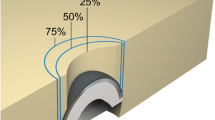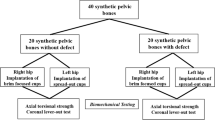Abstract
Purpose
This experimental study was undertaken to examine the fixation characteristics of a six-finned acetabular cup in both primary and revision arthroplasty in comparison with two other commonly used cup designs without fins.
Methods
All three cup designs (Ananova® [Intraplant], Plasmacup® NSC [Aesculap]; Exceed ABT™ [Biomet]) were implanted into validated models of normal and revision acetabula. The defect models were designed to simulate a dorso-cranial rim defect of 90° width and 10 mm in depth (moderate rim defect) and a dorso-cranial rim defect of 130° width and 15 mm in depth (severe rim defect). The fixation strength of the three cup designs was tested by cyclically edge-loading the implanted cups using a mechanical testing machine.
Results
The six-finned Ananova implant exhibited greater resistance to foam-cup interface motion than both the Plasmacup and Exceed ABT implants. The largest average differences were observed in the resistance to ultimate spin-out, with Ananova outperforming Exceed ABT and Plasmacup by 26 % and 17 % in the moderate and by 36 % and 38 % in the severe defect models, respectively.
Conclusions
The six-finned Ananova cup was significantly more resistant to edge loading both in the normal acetabulum and in acetabula with moderate to severe dorso-cranial rim defects than cup designs without fins, indicating that it may cover a wider range of clinical indications than conventional press-fit cups and provide clinicians with the confidence that, in primary and simple revision arthroplasty, adequate fixation strength can be obtained.





Similar content being viewed by others
References
Widmer KH, Zurfluh B, Morscher EW (2002) Load transfer and fixation mode of press-fit acetabular sockets. J Arthroplasty 17(7):926–935
Elke R, Berli B, Wagner A, Morscher EW (2003) Acetabular revision in total hip replacement with a press-fit cup. J Bone Joint Surg Br 85(8):1114–1119
Pulido L, Rachala SR, Cabanela ME (2011) Cementless acetabular revision: past, present, and future. Revision total hip arthroplasty: the acetabular side using cementless implants. Int Orthop 35(2):289–298
Bellini CM, Galbusera F, Ceroni RG, Raimondi MT (2007) Loss in mechanical contact of cementless acetabular prostheses due to post-operative weight bearing: a biomechanical model. Med Eng Phys 29(2):175–181
Pilliar RM, Lee JM, Maniatopoulos C (1986) Observations on the effect of movement on bone ingrowth into porous-surfaced implants. Clin Orthop Relat Res 208:108–113
Curtis MJ, Jinnah RH, Wilson VD, Hungerford DS (1992) The initial stability of uncemented acetabular components. J Bone Joint Surg Br 74(3):372–376
Adler E, Stuchin SA, Kummer FJ (1992) Stability of press-fit acetabular cups. J Arthroplasty 7(3):295–301
Kwong LM, O’Connor DO, Sedlacek RC, Krushell RJ, Maloney WJ, Harris WH (1994) A quantitative in vitro assessment of fit and screw fixation on the stability of a cementless hemispherical acetabular component. J Arthroplasty 9(2):163–170
Roth A, Winzer T, Sander K, Anders JO, Venbrocks RA (2006) Press fit fixation of cementless cups: how much stability do we need indeed? Arch Orthop Trauma Surg 126(2):77–81
Larsson S, Elloy M, Hansson LI (1987) Fixation of trochanteric hip fractures. A cadaver study of static and dynamic loading. Acta Orthop Scand 58(4):365–368
MacKenzie JR, Callaghan JJ, Pedersen DR, Brown TD (1994) Areas of contact and extent of gaps with implantation of oversized acetabular components in total hip arthroplasty. Clin Orthop Relat Res 298:127–136
Morscher EW (1992) Current status of acetabular fixation in primary total hip arthroplasty. Clin Orthop Relat Res 274:172–193
Schmalzried TP, Wessinger SJ, Hill GE, Harris WH (1994) The Harris-Galante porous acetabular component press-fit without screw fixation. Five-year radiographic analysis of primary cases. J Arthroplasty 9(3):235–242
Won CH, Hearn TC, Tile M (1995) Micromotion of cementless hemispherical acetabular components. Does press-fit need adjunctive screw fixation? J Bone Joint Surg Br 77(3):484–489
Zilkens C, Djalali S, Bittersohl B et al (2011) Migration pattern of cementless press fit cups in the presence of stabilizing screws in total hip arthroplasty. Eur J Med Res 16(3):127–132
Udomkiat P, Dorr LD, Wan Z (2002) Cementless hemispheric porous-coated sockets implanted with press-fit technique without screws: average ten-year follow-up. J Bone Joint Surg Am 84-A(7):1195–1200
Templeton JE, Callaghan JJ, Goetz DD, Sullivan PM, Johnston RC (2001) Revision of a cemented acetabular component to a cementless acetabular component. A ten to fourteen-year follow-up study. J Bone Joint Surg Am 83-A(11):1706–1711
Paprosky WG, Perona PG, Lawrence JM (1994) Acetabular defect classification and surgical reconstruction in revision arthroplasty. A 6-year follow-up evaluation. J Arthroplasty 9(1):33–44
Keating EM, Ritter MA, Faris PM (1990) Structures at risk from medially placed acetabular screws. J Bone Joint Surg Am 72(4):509–511
Wasielewski RC, Galat DD, Sheridan KC, Rubash HE (2005) Acetabular anatomy and transacetabular screw fixation at the high hip center. Clin Orthop Relat Res 438:171–176
Kirkpatrick JS, Callaghan JJ, Vandemark RM, Goldner RD (1990) The relationship of the intrapelvic vasculature to the acetabulum. Implications in screw-fixation acetabular components. Clin Orthop Relat Res 258:183–190
Cipriano CA, Issack PS, Beksac B, Della Valle AG, Sculco TP, Salvati EA (2008) Metallosis after metal-on-polyethylene total hip arthroplasty. Am J Orthop (Belle Mead NJ) 37(2):E18–E25
Jasty M, Bragdon C, Jiranek W, Chandler H, Maloney W, Harris WH (1994) Etiology of osteolysis around porous-coated cementless total hip arthroplasties. Clin Orthop Relat Res 308:111–126
Wilson-MacDonald J, Morscher E, Masar Z (1990) Cementless uncoated polyethylene acetabular components in total hip replacement. Review of five- to 10-year results. J Bone Joint Surg Br 72(3):423–430
Maloney WJ, Peters P, Engh CA, Chandler H (1993) Severe osteolysis of the pelvic in association with acetabular replacement without cement. J Bone Joint Surg Am 75(11):1627–1635
Berman AT, Avolio A Jr, DelGallo W (1994) Acetabular osteolysis in total hip arthroplasty: prevention and treatment. Orthopedics 17(10):963–965
Galat DD, Petrucci JA, Wasielewski RC (2004) Radiographic evaluation of screw position in revision total hip arthroplasty. Clin Orthop Relat Res 419:124–129
Jamieson ML, Russell RD, Incavo SJ, Noble PC (2011) Does an enhanced surface finish improve acetabular fixation in revision total hip arthroplasty? J Arthroplasty 26(4):644–648
Ries MD, Salehi A, Shea J (1999) Photoelastic analysis of stresses produced by different acetabular cups. Clin Orthop Relat Res 369:165–174
Baleani M, Fognani R, Toni A (2001) Initial stability of a cementless acetabular cup design: experimental investigation on the effect of adding fins to the rim of the cup. Artif Organs 25(8):664–669
Conflict of interest
The authors declare that they have no conflict of interest.
Author information
Authors and Affiliations
Corresponding author
Rights and permissions
About this article
Cite this article
Huber, W.O., Noble, P.C. Effect of design on the initial stability of press-fit cups in the presence of acetabular rim defects: experimental evaluation of the effect of adding circumferential fins. International Orthopaedics (SICOT) 38, 725–731 (2014). https://doi.org/10.1007/s00264-013-2187-8
Received:
Accepted:
Published:
Issue Date:
DOI: https://doi.org/10.1007/s00264-013-2187-8




